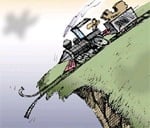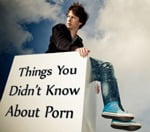Kids today have access to super-stimulating porn that may lead to erectile dysfunction, social anxiety, and other problems.
 In 2006 limitless quantities of free, shocking, explicit videos became widely available to savvy Internet users with high-speed connections. Alas, some of the planet’s most talented computer wizards are youngsters. Passing around outrageous pornographic video clips is now a popular social activity.
In 2006 limitless quantities of free, shocking, explicit videos became widely available to savvy Internet users with high-speed connections. Alas, some of the planet’s most talented computer wizards are youngsters. Passing around outrageous pornographic video clips is now a popular social activity.
Such videos are often so extreme that they dumbfound even the most freethinking parents. According to psychiatrist Norman Doidge in The Brain That Changes Itself, porn grows more shocking because today’s porn users tend to habituate to material viewed. That is, today’s superstimulating porn, instead of satisfying more, numbs the brain’s pleasure response. Then the user needs something even more shocking to get aroused—which the porn industry continuously delivers. Who’s gonna get excited by “PacMan” when he has been playing “Grand Theft Auto” or “Halo 3”?
The more novel, startling, “sinful,” forbidden, or even disgusting, a video is, the cooler it is to pass around. Also, the more it excites a viewer’s brain (specifically, the reward circuitry). Climax then reinforces the “value” of the material that produces the climax. So, kids’ brains are now rewiring to value brain-jolting material for which nothing in their (or most anyone’s) experience has prepared them. Norepinephine released in response to shocking images also appears to reinforce this learning.
While video games also flood the brain with dopamine, it’s evident that sexual content activates additional aspects of the brain’s reward circuitry. As kids mature, sexual reproduction signals trump video-game thrills.
The brain changes that follow repeated stimulation can have surprising effects. Young men report that their sexual tastes sometimes morph in unexpected directions, and that they become less responsive to normal flirting. Sure, part of their brain still wants a sweetheart with whom to do the usual, rewarding teenage things. Yet another part wants a porn star’s moans of artificial desire, which their brains associate with fleeting relief.
Since I began sharing the correlations men are discovering between heavy Internet porn use and symptoms like erectile dysfunction and social anxiety, I’ve been hearing from younger and younger guys struggling with such symptoms. (As an aside, users who manage to avoid extreme stimulation do not seem to report unusual erectile dysfunction problems.) Here’s a sample:
I’m hoping to recover and get aroused more around girls. I have been going insane thinking that my sex life is over. I am 15 years old and I’ve been masturbating since I was 12. It started out as just simple videos but now I have been getting into more extreme stuff. … Can you explain to me the basic steps I need to take to recover please? … I have to ask this so that my mind can rest and I can feel confident. Is there any permanent damage done to me? If I successfully quit porn will my limb stay up when I become sexually active in the future? Or will I have ED issues?
Science has not investigated or verified the answers to his questions. First, who can find porn virgins of a suitable age to test? Second, who deliberately wants to expose kids to superstimulating, aberrant erotic videos to see what happens in their brains, or how it alters their sexual response over time?
It has long been known that overstimulating the brain’s reward circuit with drugs can cause cravings for more and more. Now, research is revealing that non-drug, “natural” things, like junk food, can alter the neurochemical balance of this part of the brain like drugs—numbing response to normal stimuli. The symptoms heavy porn users report suggest that their brains are experiencing these very changes. (Slowly, both porn’s risks and the benefits from leaving it behind are becoming evident.)
If a guy has been viewing porn videos since puberty, or before, how would he know if his (lack of) response to potential sweethearts, his kinky tastes, or his masturbation cravings are normal for him? He has nothing with which to compare. Sexologist Jakob Pastötter gives an example of how porn shapes perception:
When Kinsey did his studies in the 40s, not even gay men practiced anal sex frequently. The first changes occurred during the 70s in the gay scene and then, especially under the influence of the so-called gonzo pornography, also in heterosexual circles. Suddenly, anal sex seems to have become quite a common practice. And accordingly, sex counsellors report that not too long ago the first boys enquired, “How can I persuade my girlfriend to have anal sex?” Then, a few years later, came the first girls, “How can I dissuade my boyfriend from anal sex?” Now, the girls come and ask the sex counsellors, “What pills can I take to prevent it hurting like hell?” All this in a period of only fifteen years, which began when anal sex was introduced in pornography as a common sex variant, in the mid-90s approximately.
Today, it is not unheard of for straight kids to become hooked on transsexual porn, autoerotic asphyxiation, bondage or violent rape porn. It can be very unnerving for them to be having erections/orgasms to material that conflicts with their self-image.
What’s a parent to do?
Would your child discuss his porn escalation or disturbing symptoms with you? And if he does, will you be able to explain why today’s porn is riskier than erotica of the past? Can you give practical advice about managing sexual desire and masturbation? Most parents cross their fingers, remind themselves that they survived encounters with Playboy, and hope their kids will figure things out for themselves.
Yet today’s porn is nothing like Playboy. It’s video, so the user can effortlessly imagine himself in a role. It’s always novel, and there’s no limit to how much can be viewed. Even after climax a user can keep going by clicking to something more shocking. The issue isn’t masturbation or whether content is “good” or “bad.” The issue is the effects of Internet porn’s extreme stimulation on the brain.
Due to a search-engine fluke, my husband and I have been listening to the woes of recovering porn users for almost five years. More and more of them are in their twenties or even younger, and quite alarmed by the tenacity of their unwanted symptoms. They are grateful for clear explanations of how their brains have been affected and how to restore normal responsiveness. (For more, visit Your Brain On Porn.)
 It’s difficult to know what to tell kids to help them steer for balance in today’s superstimulating environment. However, based on the stories we’ve been hearing, here are some suggestions. Whether or not you find them helpful, do find a way to discuss today’s porn with your child.
It’s difficult to know what to tell kids to help them steer for balance in today’s superstimulating environment. However, based on the stories we’ve been hearing, here are some suggestions. Whether or not you find them helpful, do find a way to discuss today’s porn with your child.
1. Avoid threats and shaming. Risky activities release extra adrenaline and dopamine into the brain, and are therefore paradoxically perceived as more “valuable.” (The brain’s primitive reward circuitry assesses value based upon neurochemicals released in connection with an activity.) Threats of future punishment and warnings against “sin” therefore increase porn’s power to overstimulate the brain, making subsequent binging more likely. Keep in mind that someone who is drawn to sexy images is just doing what his brain evolved to do: looking to reproduce. The worse a user feels about his behavior, the more likely he is to seek its temporary, brain-chemical oblivion to ward off anxiety.
2. Masturbation is not the ideal mood medicine. Because climax offers temporary relief from anxiety, lack of focus and insomnia, it seems like a cure. Kids can easily get in the habit of masturbating to regulate mood. Unfortunately, too frequent climax can make tension worse over the following days. Kids need other ways to regulate mood. Vigorous exercise, friendly interaction with others, trusted companionship, time in nature, affectionate touch/hugs, doing something creative, singing, time with pets, meditation, and service to others have all been shown to help reduce stress and/or regulate mood—probably because they improve brain balance. (One dad helped his porn-hooked teen by teaching him an ancient technique for redistributing sexual energy when urges arose.)
3. Understand the escalation problem. Point out that our brains are generally calibrated for genitals achieving normal degrees of stimulation and arousal. Once we move to new thresholds of stimulation (today’s super-porn or sex toys), we risk making our brains temporarily less sensitive to subtler, ordinary stimuli. Internet porn may be the quickest way to get off, but hotter porn doesn’t satisfy users’ sexual needs better. It tends to inflame them. This can make future fulfillment harder to achieve, leading to more shocking material or more vigorous stimulation.
4. Find a balance. Explain that the urge to masturbate is normal. It arises primarily from a genetic longing for soothing connection with another. Once kids understand that especially intense stimulation can make this innate urge increasingly demanding, they can experiment with ways to minimize escalation. Paradoxically, they may find that infrequent masturbation actually works best. This concept may seem anathema today, but it’s possible our hunter-gatherer ancestors masturbated far less than we do, and were actually less horny. They didn’t have to contend with today’s synthetically induced overstimulation. Working toward their chosen schedule, however imperfectly, also increases kids’ self-discipline—a useful life-skill.
5. Stick to natural stimuli. In line with the “less can be more” suggestion, tell kids that masturbation based on their own imaginings of real potential mates and realistic, affectionate sexual encounters will be least problematic. If imagination isn’t getting them to climax, it’s probably because their brains haven’t returned to full sensitivity since their previous climax. In the long run, it is better to wait than to turn to today’s porn (or porn flashbacks) to get the job done.
6. Porn is unrealistic. Sadly, today’s porn often makes non-alpha male kids doubt their future desirability simply because they can’t see themselves in the standard leading role. Point out that a partner’s satisfaction is not dependent upon the huge, unflagging erection or other characteristics of a porn star. Nor is a man’s pleasure dependent upon the hairless genitals, non-standard sexual acts, or breast implants of his partner. Explain that porn actors are paid sexual athletes who specialize in creating illusions of intense arousal—not in producing warm feelings of lasting satisfaction or even pleasure. Paint a mental picture for your child of satisfying sex.
 Kids typically see their first Internet pornography by age eleven, or even younger these days. If you cannot think of a good way to open the porn discussion with your child, you may want to watch some of these free videos from various sources. You can also make it harder for porn to become a habit by protecting your home computers (and your child’s cell phone) with free porn blockers.
Kids typically see their first Internet pornography by age eleven, or even younger these days. If you cannot think of a good way to open the porn discussion with your child, you may want to watch some of these free videos from various sources. You can also make it harder for porn to become a habit by protecting your home computers (and your child’s cell phone) with free porn blockers.
Research shows that a strong, supportive parental relationship can protect kids against risky behavior, even in those who are genetically vulnerable. Encourage your child to ask questions. Accept that ultimately he/she will have to make his/her own decisions. All you can do is offer solid information, your loving support, and a healthy example. That may be all that your child needs to steer for sexual balance.
Since we wrote this post a disturbing trend has emerged. Guys who used Internet porn during their adolescence often need longer to regain their erectile health, see – Young Porn Users Need Longer To Recover Their Mojo.
UPDATES
- An official diagnosis? The world’s most widely used medical diagnostic manual, The International Classification of Diseases (ICD-11), contains a new diagnosis suitable for porn addiction: “Compulsive Sexual Behavior Disorder.” (2018)
- Porn/sex addiction? This page lists 39 neuroscience-based studies (MRI, fMRI, EEG, neuropsychological, hormonal). They provide strong support for the addiction model as their findings mirror the neurological findings reported in substance addiction studies.
- The real experts’ opinions on porn/sex addiction? This list contains 16 recent literature reviews & commentaries by some of the top neuroscientists in the world. All support the addiction model.
- Signs of addiction and escalation to more extreme material? Over 30 studies reporting findings consistent with escalation of porn use (tolerance), habituation to porn, and even withdrawal symptoms (all signs and symptoms associated with addiction).
- Debunking the unsupported talking point that “high sexual desire” explains away porn or sex addiction: At least 25 studies falsify the claim that sex & porn addicts “just have high sexual desire”
- Porn and sexual problems? This list contains 26 studies linking porn use/porn addiction to sexual problems and lower arousal to sexual stimuli. The first 5 studies in the list demonstrate causation, as participants eliminated porn use and healed chronic sexual dysfunctions.
- Porn’s effects on relationships? Almost 60 studies link porn use to less sexual and relationship satisfaction. (As far as we know all studies involving males have reported more porn use linked to poorer sexual or relationship satisfaction.)
- Porn use affecting emotional and mental health? Over 55 studies link porn use to poorer mental-emotional health & poorer cognitive outcomes.
- Porn use affecting beliefs, attitudes and behaviors? Check out individual studies – over 25 studies link porn use to “un-egalitarian attitudes” toward women and sexist views – or the summary from this 2016 meta-analysis: Media and Sexualization: State of Empirical Research, 1995–2015. Excerpt:
The goal of this review was to synthesize empirical investigations testing effects of media sexualization. The focus was on research published in peer-reviewed, English-language journals between 1995 and 2015. A total of 109 publications that contained 135 studies were reviewed. The findings provided consistent evidence that both laboratory exposure and regular, everyday exposure to this content are directly associated with a range of consequences, including higher levels of body dissatisfaction, greater self-objectification, greater support of sexist beliefs and of adversarial sexual beliefs, and greater tolerance of sexual violence toward women. Moreover, experimental exposure to this content leads both women and men to have a diminished view of women’s competence, morality, and humanity.
- What about sexual aggression and porn use? Another meta-analysis: A Meta‐Analysis of Pornography Consumption and Actual Acts of Sexual Aggression in General Population Studies (2015). Excerpt:
22 studies from 7 different countries were analyzed. Consumption was associated with sexual aggression in the United States and internationally, among males and females, and in cross-sectional and longitudinal studies. Associations were stronger for verbal than physical sexual aggression, although both were significant. The general pattern of results suggested that violent content may be an exacerbating factor.
- What about the porn use and adolescents? Check out this list of over 200 adolescent studies, or this 2012 review of the research – The Impact of Internet Pornography on Adolescents: A Review of the Research (2012). From the conclusion:
Increased access to the Internet by adolescents has created unprecedented opportunities for sexual education, learning, and growth. Conversely, the risk of harm that is evident in the literature has led researchers to investigate adolescent exposure to online pornography in an effort to elucidate these relationships. Collectively, these studies suggest that youth who consume pornography may develop unrealistic sexual values and beliefs. Among the findings, higher levels of permissive sexual attitudes, sexual preoccupation, and earlier sexual experimentation have been correlated with more frequent consumption of pornography…. Nevertheless, consistent findings have emerged linking adolescent use of pornography that depicts violence with increased degrees of sexually aggressive behavior. The literature does indicate some correlation between adolescents’ use of pornography and self-concept. Girls report feeling physically inferior to the women they view in pornographic material, while boys fear they may not be as virile or able to perform as the men in these media. Adolescents also report that their use of pornography decreased as their self-confidence and social development increase. Additionally, research suggests that adolescents who use pornography, especially that found on the Internet, have lower degrees of social integration, increases in conduct problems, higher levels of delinquent behavior, higher incidence of depressive symptoms, and decreased emotional bonding with caregivers.